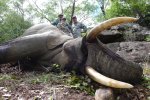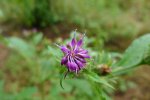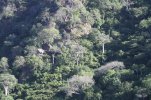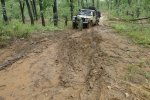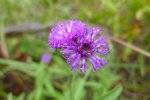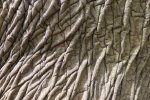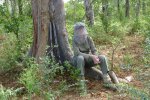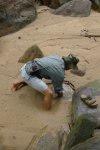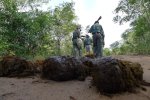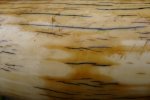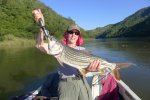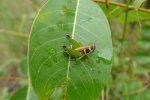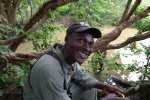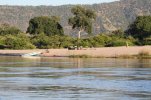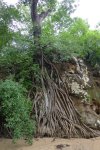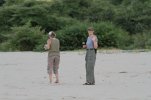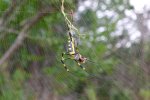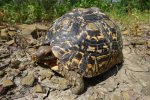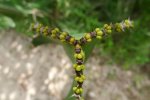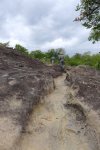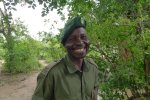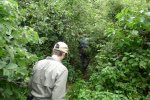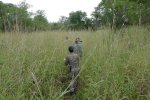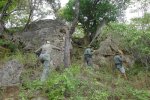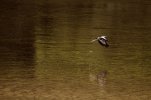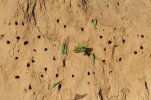Frostbit
AH veteran
- Joined
- Jun 13, 2010
- Messages
- 142
- Reaction score
- 116
- Media
- 2
- Member of
- SCI, NRA
- Hunted
- USA, Alaska, Namibia, Zambia
Location: Pedza Pasi Camp in the Zambezi Valley, Zimbabwe
Outfitter:. Charlton McCallum Safaris PH: James Durnford Charlton
Trackers: Nyati, Cryton
Driver: Eddie
Camp Manager: Chooks
Chef: Crispin
Game Scout: Cement
Council Ranger: Matombo
Cameraman: Justin Drainer
Dates: May 31 - April 13 - 2015
Areas hunted: DSA, Ward 1, Ward 2, Ward 11
Rifles:
1902 Army & Navy Double Rifle in 450 3 1/4 NE, Hand-loaded 480 grain Woodleigh Solids (and softs) 97.5 grains IMR 4831, Hornady Brass, CCI 250 primers.
Modified 1988 Ruger Model 77 Tang Safety 7 x 57, with Sellier & Bellot 173 grain factory loads.
Animals taken: Elephant Bull on Day 11
Animals seen: Bull Elephant, Cow Elephant, including Tuskless, Kudu, Warthog, Baboon, Diker, Impala, Black Mamba, Boomslang, Copious Spiders, Buffalo, Hyena, Squirrels.
James Durnford Chalton navigated the cruiser expertly along the two track road while swatting Tsetse’s from his lime green mankini clad testicles. I suddenly awoke with a startle from my Malarone driven nightmare.
RESPECT!!
That is the word I now understand to be deserved by those that put in the effort during a traditional tracking Elephant hunt. You truly do hunt them with your legs and we used ours to accomplish the goal. Respect is also the word deserved by my amazing wife who defeated cancer one year prior to this hunt and marched along with us for every kilometer other than two afternoons.
This hunt included many firsts for us on the African Continent.
-A first time to Zimbabwe.
-A first time experiencing the thick green vegetation of April that dictated an up close and personal experience with the fauna, including Elephants.
-A first time experiencing a traditional tracking Elephant Bull hunt.
-A first time hunting with Charlton McCallum Safaris.
-A first time having a professional videographer along.
The hunt was booked in 2013 before Joyce’s surgery resulting in her cancer diagnosis. We thought there was a chance the hunt would never happen. The US Government did its best to make the hunt undesirable by banning the import of ivory from Zimbabwe and then six days before our departure changing the rules for traveling from the country with firearms. To me the writing is on the wall that international hunting may well go the way of the Dodo as the ranks of hunter/conservationists dwindle and the voice of anti-hunting grows stronger creating annoying roadblocks.
I even had to question my own motives for spending a large sum of money on a foreign hunt knowing full well I would likely not be able to import the ivory. The idea of a cancelation weighed on my mind for a couple of weeks and I came to realize I would be a hypocrite to claim to be a conservationist if the ivory was the true drive for considering killing a species presently diminishing in numbers as a result of poaching and habitat pressures. I’ve always claimed that hunting, other than freezer filling here in Alaska, was about the experience. Thus I reconciled in my mind that this hunt must happen. My dollars would support the survival of the Elephant as a whole by giving it value to the locals. The meat from our Bull ended up distributed to five separate villages in time for their Independence Day celebrations.
This was a 14 day hunt with success coming on day 11. In the preceding days we experienced heavy downpours, searing sunlight, humidity challenging to we Alaskans, jesse so thick that at times I thought we might be in central Africa after Bongo and not Elephant.
My beautiful 1902 Army Navy 450 3 1/4 NE now carries many character marks that tells the tale of slipping through vegetation so thick that avoiding significant contact with the gun was impossible.
We hunted mostly in the DSA (Dande Safari Area) thus had our fair share of hill climbing and descending as well as some stream crossings and dry river bed marches.
A traditional tracking hunt such as this involves not just the physical conditioning needed to tackle the challenge but also a mental toughness. When you track an Elephant for days and then learn he is not a shooter there’s a cumulative mental toll. Joyce and I both know how to “embrace the suck” of physical challenges, but I was not prepared for how I felt after tracking an Elephant for hours only to loose the spoor in the confusion of a cow herd. Likewise it’s indescribably frustrating to track for hours only to cross the same road you started from after the Elephant circled widely during its trek. Early on in the hunt it’s a laughing matter, later it feels personal. Even Joyce, who had trouble with the idea of an Elephant dying, at one point after we lost the track of a particular Elephant we followed for days remarked, “I hope we catch this thing and you kill it”. Yes, it felt personal.
We followed one Elephant in particular we named “Deep Crack” because of the distinctive deep crack illustrated in his track. That Elephant Bull was likely in Musth and spent the majority of his time racing from one cow herd to the next. If you have read any previous hunt reports that included Buzz and his trackers Cryton & Nyati you know their reputation as a team. On previous safaris we have marveled at the skill of the trackers but I now believe we have observed probably the best Elephant bloodhounds on the African continent. The numerous times that Deep Crack mixed it up with the cows did not stop Cryton, Nyati, and Buzz from regaining the spoor. Truly an amazing talent.
I’m not going to bore you with the day to day details of this hunt but I would like to share what felt different from previous safaris and why. Joyce and I are both very happy for this experience.
The Pros:
CMS runs an organized camp and for our trip much of the details of camp life were managed by Chooks, the camp manager. Ironically she is the mother of a PH that trained with and now hunts with Derek Littleton and Luwire, our next hunt location in the Niassa Reserve of Mozambique.
Tracking hunt - because of the many, many Kilometers on foot you can expect a much more up close and personal experience with Africa. Being among an Elephant Cow Herd defies description. This is dangerous game hunting at it’s finest. We had to call off both young bulls and cows during this hunt. I always viewed the Elephant as the one animal in Africa that caused me to feel uncomfortable when in close proximity. By the end of this hunt I got used to being close. That said, Elephants command your respect.
Up close means up close! Spider webs in your face, wasps attacking with no warning. Why would I put this under the pros? The hunt occurring this early in the season gave us the opportunity to see flowers in large numbers and the insects never seen before. It’s all part of the experience, even the wasp stings I avoided. Joyce did manage to get nailed though.
The dung beetles going about their business fascinated Joyce and I. They had been absent from our previous later season trips.
Justing Drainer, the videographer brought much more to the table than his photography skills. He has a greater knowledge of the insect and bird life than Buzz and enjoyed sharing that knowledge when he saw our interest. He especially enjoyed showing the different spiders to Joyce who would be just as happy not to see them.
The Cons:
The same thick vegetation that gave this hunt its character also made it very difficult. I recommend you only consider this early season hunt if you are accepting of the fact that much will be hidden by that vegetation.
The presence of abundant water means the animals are not required to congregate near pans of water. Hunting early season is much more difficult than hunting late season from a visibility and perceived game density standpoint.
Full disclosure:
It’s always rewarding to write a hunt report and tell of your success. If you measure that in animals killed so be it. For me personally it’s about the overall experience, the maturity of the animal taken regardless of trophy size, and the quick and humane kill.
I visually imaged how the death of this Elephant would occur. I obtained my shot placement research from many sources including Buzz’s videos. I practiced with my double and adopted a left barrel rear trigger first (same as Cal Pappas) in order to avoid ever doubling the gun, which I have done in the past.
The image of a clean brain shot followed immediately by my second barrel finding the heart lung area as the bull went down replayed endlessly as we hiked. Immediately reloading from the belt was practiced at the range and at home. I was as ready as I could be.
The Elephant we tracked and eventually killed on day 11 was in a small depression with a young bull and a very young elephant. The wind was not cooperative and we slowly worked our way around the depression to get downwind.
Looking downhill the young bull was first seen. He showed nice long ivory but quite thin and he was young. As he started up the hill in our direction the larger bull came to view. Buzz felt he was a shooter and I agreed.
The mental image of shouldering the double, the safety coming off, the side brain shot placement and heart/lung followup with rapid reload played one last time in my mind as the bull emerged from the depression.
It was a side brain shot at 15-20 yards on a walking elephant and with a slight up-angle as he emerged from the depression. I could rack up all the excuses I want but they would simply be that, excuses.
My side brain shot missed the mark but my second barrel did indeed find the heart lung area. As I rapidly reloaded I did not hear any other shots.
Buzz and I had discussed early on that I would try a brain shot and if the animal didn’t immediately go down he would place a heart/lung insurance shot. He later told me he did not because he knew I hit the mark with that second shot.
I stepped to the side for a better shot at the elephant now retreating uphill in order to place a shot in an attempt to break his hip and limit his retreat. I doubled the rifle!!
I quickly reloaded and placed two shots, one at a time this time, into the right hip breaking it. The elephant stumbled and turned but did not go down. I tried two more shots for a frontal brain and neither brought the expected response although the elephant did drop at this point. He landed laying down hill with the belly side facing me. I had two rounds left in the belt which I had already reloaded into the rifle, which now had very hot barrels.
The elephant was still breathing with a very disturbing wet cacophony of sounds. I wanted this to end. I shot the last two rounds into his chest through the sternum. These both were Woodliegh softs which were in my belt in case we stumbled on a target of opportunity while returning from a failed tracking experience. The softs penetrated and caused a fountain of pulsatile blood spraying three feet from the elephant’s chest. He gurgled a few last times and fell silent.
I dreamed of this hunt for some time. I practiced!! I continually imaged how this would go. As Joyce says, “Man plans and God laughs”.
Joyce initially was not going to take part in an Elephant hunt in any way. Eventually she realized she would miss out on so much by not being in on the tracking. The plan was for her to turn away or stay back a bit when the time came for an elephant to die. She was actually right there. The young bull in the lead, when the shot rang out, passed by Joyce as close as 10 yards or less. After the last wet sound of death stopped I turned to her to ask if she was OK. She answered yes. I apologized. All my planning, imagery, and practice meant little once the lead flew.
I’m OK with this now. It took a little while.
Enjoy the pictures. The vast majority were taken by Justin Trainer. His presence is worth every penny.
The pictures will be loaded later in the second post.

Cheers
Jim
Outfitter:. Charlton McCallum Safaris PH: James Durnford Charlton
Trackers: Nyati, Cryton
Driver: Eddie
Camp Manager: Chooks
Chef: Crispin
Game Scout: Cement
Council Ranger: Matombo
Cameraman: Justin Drainer
Dates: May 31 - April 13 - 2015
Areas hunted: DSA, Ward 1, Ward 2, Ward 11
Rifles:
1902 Army & Navy Double Rifle in 450 3 1/4 NE, Hand-loaded 480 grain Woodleigh Solids (and softs) 97.5 grains IMR 4831, Hornady Brass, CCI 250 primers.
Modified 1988 Ruger Model 77 Tang Safety 7 x 57, with Sellier & Bellot 173 grain factory loads.
Animals taken: Elephant Bull on Day 11
Animals seen: Bull Elephant, Cow Elephant, including Tuskless, Kudu, Warthog, Baboon, Diker, Impala, Black Mamba, Boomslang, Copious Spiders, Buffalo, Hyena, Squirrels.
James Durnford Chalton navigated the cruiser expertly along the two track road while swatting Tsetse’s from his lime green mankini clad testicles. I suddenly awoke with a startle from my Malarone driven nightmare.

RESPECT!!
That is the word I now understand to be deserved by those that put in the effort during a traditional tracking Elephant hunt. You truly do hunt them with your legs and we used ours to accomplish the goal. Respect is also the word deserved by my amazing wife who defeated cancer one year prior to this hunt and marched along with us for every kilometer other than two afternoons.
This hunt included many firsts for us on the African Continent.
-A first time to Zimbabwe.
-A first time experiencing the thick green vegetation of April that dictated an up close and personal experience with the fauna, including Elephants.
-A first time experiencing a traditional tracking Elephant Bull hunt.
-A first time hunting with Charlton McCallum Safaris.
-A first time having a professional videographer along.
The hunt was booked in 2013 before Joyce’s surgery resulting in her cancer diagnosis. We thought there was a chance the hunt would never happen. The US Government did its best to make the hunt undesirable by banning the import of ivory from Zimbabwe and then six days before our departure changing the rules for traveling from the country with firearms. To me the writing is on the wall that international hunting may well go the way of the Dodo as the ranks of hunter/conservationists dwindle and the voice of anti-hunting grows stronger creating annoying roadblocks.
I even had to question my own motives for spending a large sum of money on a foreign hunt knowing full well I would likely not be able to import the ivory. The idea of a cancelation weighed on my mind for a couple of weeks and I came to realize I would be a hypocrite to claim to be a conservationist if the ivory was the true drive for considering killing a species presently diminishing in numbers as a result of poaching and habitat pressures. I’ve always claimed that hunting, other than freezer filling here in Alaska, was about the experience. Thus I reconciled in my mind that this hunt must happen. My dollars would support the survival of the Elephant as a whole by giving it value to the locals. The meat from our Bull ended up distributed to five separate villages in time for their Independence Day celebrations.
This was a 14 day hunt with success coming on day 11. In the preceding days we experienced heavy downpours, searing sunlight, humidity challenging to we Alaskans, jesse so thick that at times I thought we might be in central Africa after Bongo and not Elephant.
My beautiful 1902 Army Navy 450 3 1/4 NE now carries many character marks that tells the tale of slipping through vegetation so thick that avoiding significant contact with the gun was impossible.
We hunted mostly in the DSA (Dande Safari Area) thus had our fair share of hill climbing and descending as well as some stream crossings and dry river bed marches.
A traditional tracking hunt such as this involves not just the physical conditioning needed to tackle the challenge but also a mental toughness. When you track an Elephant for days and then learn he is not a shooter there’s a cumulative mental toll. Joyce and I both know how to “embrace the suck” of physical challenges, but I was not prepared for how I felt after tracking an Elephant for hours only to loose the spoor in the confusion of a cow herd. Likewise it’s indescribably frustrating to track for hours only to cross the same road you started from after the Elephant circled widely during its trek. Early on in the hunt it’s a laughing matter, later it feels personal. Even Joyce, who had trouble with the idea of an Elephant dying, at one point after we lost the track of a particular Elephant we followed for days remarked, “I hope we catch this thing and you kill it”. Yes, it felt personal.
We followed one Elephant in particular we named “Deep Crack” because of the distinctive deep crack illustrated in his track. That Elephant Bull was likely in Musth and spent the majority of his time racing from one cow herd to the next. If you have read any previous hunt reports that included Buzz and his trackers Cryton & Nyati you know their reputation as a team. On previous safaris we have marveled at the skill of the trackers but I now believe we have observed probably the best Elephant bloodhounds on the African continent. The numerous times that Deep Crack mixed it up with the cows did not stop Cryton, Nyati, and Buzz from regaining the spoor. Truly an amazing talent.
I’m not going to bore you with the day to day details of this hunt but I would like to share what felt different from previous safaris and why. Joyce and I are both very happy for this experience.
The Pros:
CMS runs an organized camp and for our trip much of the details of camp life were managed by Chooks, the camp manager. Ironically she is the mother of a PH that trained with and now hunts with Derek Littleton and Luwire, our next hunt location in the Niassa Reserve of Mozambique.
Tracking hunt - because of the many, many Kilometers on foot you can expect a much more up close and personal experience with Africa. Being among an Elephant Cow Herd defies description. This is dangerous game hunting at it’s finest. We had to call off both young bulls and cows during this hunt. I always viewed the Elephant as the one animal in Africa that caused me to feel uncomfortable when in close proximity. By the end of this hunt I got used to being close. That said, Elephants command your respect.
Up close means up close! Spider webs in your face, wasps attacking with no warning. Why would I put this under the pros? The hunt occurring this early in the season gave us the opportunity to see flowers in large numbers and the insects never seen before. It’s all part of the experience, even the wasp stings I avoided. Joyce did manage to get nailed though.
The dung beetles going about their business fascinated Joyce and I. They had been absent from our previous later season trips.
Justing Drainer, the videographer brought much more to the table than his photography skills. He has a greater knowledge of the insect and bird life than Buzz and enjoyed sharing that knowledge when he saw our interest. He especially enjoyed showing the different spiders to Joyce who would be just as happy not to see them.
The Cons:
The same thick vegetation that gave this hunt its character also made it very difficult. I recommend you only consider this early season hunt if you are accepting of the fact that much will be hidden by that vegetation.
The presence of abundant water means the animals are not required to congregate near pans of water. Hunting early season is much more difficult than hunting late season from a visibility and perceived game density standpoint.
Full disclosure:
It’s always rewarding to write a hunt report and tell of your success. If you measure that in animals killed so be it. For me personally it’s about the overall experience, the maturity of the animal taken regardless of trophy size, and the quick and humane kill.
I visually imaged how the death of this Elephant would occur. I obtained my shot placement research from many sources including Buzz’s videos. I practiced with my double and adopted a left barrel rear trigger first (same as Cal Pappas) in order to avoid ever doubling the gun, which I have done in the past.
The image of a clean brain shot followed immediately by my second barrel finding the heart lung area as the bull went down replayed endlessly as we hiked. Immediately reloading from the belt was practiced at the range and at home. I was as ready as I could be.
The Elephant we tracked and eventually killed on day 11 was in a small depression with a young bull and a very young elephant. The wind was not cooperative and we slowly worked our way around the depression to get downwind.
Looking downhill the young bull was first seen. He showed nice long ivory but quite thin and he was young. As he started up the hill in our direction the larger bull came to view. Buzz felt he was a shooter and I agreed.
The mental image of shouldering the double, the safety coming off, the side brain shot placement and heart/lung followup with rapid reload played one last time in my mind as the bull emerged from the depression.
It was a side brain shot at 15-20 yards on a walking elephant and with a slight up-angle as he emerged from the depression. I could rack up all the excuses I want but they would simply be that, excuses.
My side brain shot missed the mark but my second barrel did indeed find the heart lung area. As I rapidly reloaded I did not hear any other shots.
Buzz and I had discussed early on that I would try a brain shot and if the animal didn’t immediately go down he would place a heart/lung insurance shot. He later told me he did not because he knew I hit the mark with that second shot.
I stepped to the side for a better shot at the elephant now retreating uphill in order to place a shot in an attempt to break his hip and limit his retreat. I doubled the rifle!!
I quickly reloaded and placed two shots, one at a time this time, into the right hip breaking it. The elephant stumbled and turned but did not go down. I tried two more shots for a frontal brain and neither brought the expected response although the elephant did drop at this point. He landed laying down hill with the belly side facing me. I had two rounds left in the belt which I had already reloaded into the rifle, which now had very hot barrels.
The elephant was still breathing with a very disturbing wet cacophony of sounds. I wanted this to end. I shot the last two rounds into his chest through the sternum. These both were Woodliegh softs which were in my belt in case we stumbled on a target of opportunity while returning from a failed tracking experience. The softs penetrated and caused a fountain of pulsatile blood spraying three feet from the elephant’s chest. He gurgled a few last times and fell silent.
I dreamed of this hunt for some time. I practiced!! I continually imaged how this would go. As Joyce says, “Man plans and God laughs”.
Joyce initially was not going to take part in an Elephant hunt in any way. Eventually she realized she would miss out on so much by not being in on the tracking. The plan was for her to turn away or stay back a bit when the time came for an elephant to die. She was actually right there. The young bull in the lead, when the shot rang out, passed by Joyce as close as 10 yards or less. After the last wet sound of death stopped I turned to her to ask if she was OK. She answered yes. I apologized. All my planning, imagery, and practice meant little once the lead flew.
I’m OK with this now. It took a little while.
Enjoy the pictures. The vast majority were taken by Justin Trainer. His presence is worth every penny.
The pictures will be loaded later in the second post.

Cheers
Jim
Attachments
Last edited by a moderator:
